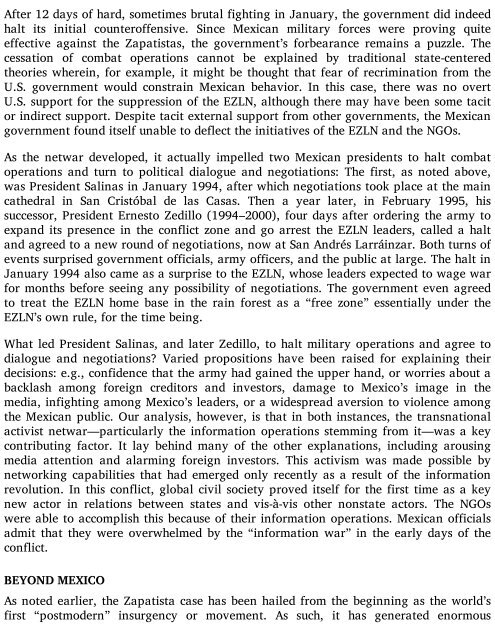RAND_MR1382
You also want an ePaper? Increase the reach of your titles
YUMPU automatically turns print PDFs into web optimized ePapers that Google loves.
After 12 days of hard, sometimes brutal fighting in January, the government did indeed<br />
halt its initial counteroffensive. Since Mexican military forces were proving quite<br />
effective against the Zapatistas, the government’s forbearance remains a puzzle. The<br />
cessation of combat operations cannot be explained by traditional state-centered<br />
theories wherein, for example, it might be thought that fear of recrimination from the<br />
U.S. government would constrain Mexican behavior. In this case, there was no overt<br />
U.S. support for the suppression of the EZLN, although there may have been some tacit<br />
or indirect support. Despite tacit external support from other governments, the Mexican<br />
government found itself unable to deflect the initiatives of the EZLN and the NGOs.<br />
As the netwar developed, it actually impelled two Mexican presidents to halt combat<br />
operations and turn to political dialogue and negotiations: The first, as noted above,<br />
was President Salinas in January 1994, after which negotiations took place at the main<br />
cathedral in San Cristóbal de las Casas. Then a year later, in February 1995, his<br />
successor, President Ernesto Zedillo (1994–2000), four days after ordering the army to<br />
expand its presence in the conflict zone and go arrest the EZLN leaders, called a halt<br />
and agreed to a new round of negotiations, now at San Andrés Larráinzar. Both turns of<br />
events surprised government officials, army officers, and the public at large. The halt in<br />
January 1994 also came as a surprise to the EZLN, whose leaders expected to wage war<br />
for months before seeing any possibility of negotiations. The government even agreed<br />
to treat the EZLN home base in the rain forest as a “free zone” essentially under the<br />
EZLN’s own rule, for the time being.<br />
What led President Salinas, and later Zedillo, to halt military operations and agree to<br />
dialogue and negotiations? Varied propositions have been raised for explaining their<br />
decisions: e.g., confidence that the army had gained the upper hand, or worries about a<br />
backlash among foreign creditors and investors, damage to Mexico’s image in the<br />
media, infighting among Mexico’s leaders, or a widespread aversion to violence among<br />
the Mexican public. Our analysis, however, is that in both instances, the transnational<br />
activist netwar—particularly the information operations stemming from it—was a key<br />
contributing factor. It lay behind many of the other explanations, including arousing<br />
media attention and alarming foreign investors. This activism was made possible by<br />
networking capabilities that had emerged only recently as a result of the information<br />
revolution. In this conflict, global civil society proved itself for the first time as a key<br />
new actor in relations between states and vis-à-vis other nonstate actors. The NGOs<br />
were able to accomplish this because of their information operations. Mexican officials<br />
admit that they were overwhelmed by the “information war” in the early days of the<br />
conflict.<br />
BEYOND MEXICO<br />
As noted earlier, the Zapatista case has been hailed from the beginning as the world’s<br />
first “postmodern” insurgency or movement. As such, it has generated enormous










![Genki - An Integrated Course in Elementary Japanese II [Second Edition] (2011), WITH PDF BOOKMARKS!](https://img.yumpu.com/58322134/1/180x260/genki-an-integrated-course-in-elementary-japanese-ii-second-edition-2011-with-pdf-bookmarks.jpg?quality=85)
![Genki - An Integrated Course in Elementary Japanese I [Second Edition] (2011), WITH PDF BOOKMARKS!](https://img.yumpu.com/58322120/1/182x260/genki-an-integrated-course-in-elementary-japanese-i-second-edition-2011-with-pdf-bookmarks.jpg?quality=85)





